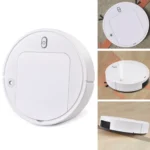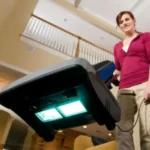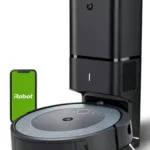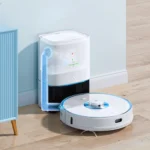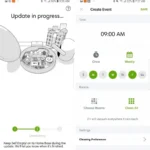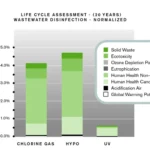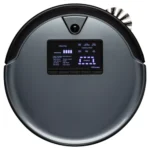Walking on a spotless and germ-free floor is a desire every homeowner has. However, traditional vacuum cleaners merely suck up debris and dirt but still leaves behind some bacteria and viruses. Recently, smart vacuum cleaners with UV sterilization technology have become increasingly popular. Nonetheless, how does UV sterilization work, and is it a game-changer in home cleaning? In this article, we will explore the science behind UV sterilization and how it works in smart vacuum cleaners. We will also examine the benefits and drawbacks of using UV sterilization technology to keep your home free from germs, bacteria, and viruses. Let’s dive in!
What is UV Sterilization Technology?

UV sterilization technology utilizes ultraviolet (UV) light to kill bacteria and viruses, making it an effective way to clean and sanitize surfaces. UV light has been used for decades in hospitals, laboratories, and other settings to disinfect surfaces and equipment. With the advent of smart vacuum cleaners, UV sterilization technology has become accessible and affordable for home use.
UV rays are part of the electromagnetic spectrum, and they are divided into three categories based on their wavelength: UVA, UVB, and UVC. UVA and UVB rays are what cause sunburns and skin damage, but UVC rays have the shortest wavelength and are the most powerful. UVC light is able to destroy the DNA of bacteria and viruses, rendering them harmless.
This process is called photodamage, and it occurs when UVC light penetrates the cell wall of the bacteria or virus, damaging the DNA and preventing it from reproducing. Unlike traditional cleaning products, UV sterilization technology does not require any chemicals, making it a safer and more eco-friendly option.
UV sterilization technology is particularly useful in home cleaning because it can eliminate bacteria and viruses that may be missed by traditional cleaning methods. Smart vacuum cleaners equipped with UV sterilization technology are able to sanitize surfaces while they clean, making it a time-efficient option for busy households.
In addition to killing bacteria and viruses, UV sterilization technology can also eliminate odors and prevent the spread of allergens. This can be particularly important for individuals with allergies or respiratory issues.
UV sterilization technology is an effective and safe way to sanitize surfaces and improve the cleanliness of your home. To learn more about the benefits and drawbacks of using UV sterilization technology in smart vacuum cleaners, check out our guide to the benefits of UV sterilization in smart vacuums.
The Science Behind UV Sterilization
UV sterilization technology uses a specific wavelength of ultraviolet light to kill or inactivate bacteria, viruses, and other microorganisms. The ultraviolet light destroys the DNA of these microorganisms, rendering them unable to reproduce and leaving them essentially dead. This is achieved through the use of UV-C light, which is a type of ultraviolet light that has the shortest wavelength and highest energy.
When exposed to UV-C light, microorganisms are damaged by the radiation, specifically by the absorption of the energy from the light. This causes mutations in their DNA, which leads to the loss of their ability to replicate and reproduce, ultimately killing the microorganisms. The effectiveness of the UV-C light depends on the intensity and duration of the exposure, as well as the type of microorganism being targeted.
UV sterilization technology has been used for decades in various applications, including hospitals, laboratories, and water treatment facilities. In recent years, it has become increasingly popular in home cleaning products, including smart vacuum cleaners.
UV sterilization technology offers several advantages over traditional cleaning methods. It is non-toxic, eco-friendly, and does not require the use of harsh chemicals. Additionally, it is effective against a wide range of microorganisms, including bacteria, viruses, and fungi. Compared to traditional chemical cleaners, UV sterilization technology offers a more thorough and complete cleaning experience.
In smart vacuum cleaners, UV-C light bulbs are typically used in combination with other cleaning mechanisms, such as suction and brushes. The placement of the UV light in the vacuum cleaner is designed to maximize exposure to surfaces that are known to harbor bacteria and other microorganisms. The duration of the UV sterilization cycle varies depending on the vacuum cleaner model, but typically ranges from a few minutes to several hours.
While UV sterilization technology offers numerous benefits, it is not a replacement for deep cleaning. It may be effective at killing surface-level bacteria, but it cannot eliminate deep-seated dirt, grime, or stains. Additionally, UV sterilization technology requires more time and energy than traditional cleaning methods, as the vacuum cleaner must be left on for several minutes to achieve the desired results.
UV sterilization technology is an effective and eco-friendly cleaning solution for homes. It offers numerous benefits, including the elimination of harmful microorganisms, deodorization, and allergy prevention. However, it is important to understand its limitations and use it in conjunction with other cleaning methods for a truly clean home. To learn more about how UV sterilization technology works in smart vacuum cleaners, check out our smart vacuum UV sterilization guide.
Why is UV Sterilization Important for Home Cleaning?
UV Sterilization Technology is becoming increasingly important for home cleaning due to the numerous benefits it offers. Traditional cleaning methods like sweeping, mopping, and wiping surfaces are not always effective in removing bacteria, viruses, and other microorganisms. These microorganisms can lead to the spread of illnesses and infections, especially in households with children and pets. Additionally, harsh chemicals used in traditional cleaning methods can pose a risk to human health and the environment.
UV Sterilization Technology offers a solution to these problems by providing an effective, efficient, and eco-friendly cleaning method. UV Sterilization uses ultraviolet light to eliminate germs, bacteria, and viruses from surfaces and air, making it an ideal complement to traditional cleaning methods. UV Sterilization effectively inactivates the DNA and RNA of microorganisms, rendering them unable to reproduce and spread.
Compared to traditional cleaning methods, UV Sterilization technology is more effective in eliminating pathogens, from both surfaces and air. The technology ensures that air and surfaces are completely free of microorganisms that cause asthma, allergies, and other health problems. In fact, studies have shown that UV sterilization technology can destroy up to 99.9% of bacteria and viruses.
Smart vacuum cleaners with UV Sterilization technology offer homeowners an added advantage against allergens in the home. UV technology in smart vacuum cleaners can effectively remove pet dander and prevent its spread, so individuals suffering from allergies can take a breath of relief. Additionally, using UV technology in smart vacuum cleaners eliminates the need for traditional cleaning chemicals, reducing the risk of allergic reactions caused by harsh chemicals.
Apart from being eco-friendly and effective, UV Sterilization Technology offers a great solution for households with kids and pets. It ensures that the home is not only clean but also free from germs, bacteria, and other harmful microorganisms. Considering the benefits, it is no surprise that UV Sterilization Technology is fast becoming a popular feature in smart vacuum cleaners used by homeowners across the world.
If you want to know more about the top smart vacuums with UV technology, check out our article on Top 5 Smart Vacuums with UV Technology.
How Does UV Sterilization Work in Smart Vacuum Cleaners?

UV sterilization technology is a ground-breaking innovation which has revolutionized the way we clean our homes. UV stands for ‘ultraviolet’, which refers to a specific wavelength of light beyond the visible spectrum. This wavelength has the ability to kill bacteria and viruses by damaging their DNA and RNA. So, how does UV sterilization work in smart vacuum cleaners?
UV Light Bulbs
Smart vacuum cleaners use UV light bulbs to emit ultraviolet light during the cleaning process. These bulbs are specially designed to produce the correct wavelength of light required to kill microorganisms, and they are typically located in the cleaning head of the vacuum cleaner. UV light bulbs can last for thousands of hours of continuous use, with a typical lifespan of around two years.
Placement of UV Light in Smart Vacuum Cleaners
The placement of UV light in smart vacuum cleaners is crucial for maximum effectiveness. Typically, the UV light is positioned right before the suction fan, which means that any microorganisms that are exposed to the light will be sucked up into the vacuum cleaner and trapped in the dustbin. The light is placed at a specific distance away from the surface being cleaned to ensure maximum coverage and exposure.
Duration of UV Sterilization Cycle
The duration of the UV sterilization cycle can vary depending on the make and model of the smart vacuum cleaner. Typically, the cycle lasts anywhere from 10 to 20 minutes. This length of time is designed to ensure that all surfaces are thoroughly exposed to the UV light, which guarantees the maximum effect of killing bacteria and viruses.
Effectiveness of UV Sterilization Technology
UV sterilization technology is incredibly effective at killing bacteria and viruses. It has been shown to eliminate up to 99.9% of germs on surfaces, which makes it a potent tool for fighting against harmful microorganisms in our homes. However, it’s essential to note that the effectiveness of UV sterilization depends on the strength and duration of the UV light exposure, as well as the distance between the surface and the UV light bulb.
The use of UV sterilization technology in smart vacuum cleaners is an important advancement in home cleaning. If you’re interested in learning more about the difference between UVC and UVA light in smart vacs, or how smart vacuum cleaners with UV sterilization can help with allergies, check out some of our other articles, like /uvc-vs-uva-in-smart-vacs/ or /smart-vacuum-cleansers-uv-sterilization-allergies/. Additionally, if you’re interested in keeping your home clean and healthy, you can find out more about using smart vacuums with UV technology at /clean-smart-vacuum-uv-tech/.
UV Light Bulbs
UV sterilization technology relies on ultraviolet (UV) light bulbs to function. These specialized bulbs emit a specific wavelength of light that can neutralize bacteria, viruses, and other microorganisms.
What makes these bulbs special? They contain mercury vapor that, when electricity is applied, excites the mercury atoms, causing them to release ultraviolet radiation. The radiation produced by these bulbs is defined as UVC, which is the most mutagenic type of UV radiation. This means it has the power to penetrate microorganisms’ cells and disrupt their DNA, rendering them harmless.
However, not all UV light bulbs are created equal. There are different types and intensities, and the most effective ones for sterilizing purposes are low-pressure mercury lamps. These lamps are designed to emit a wavelength at around 253.7 nanometers, which is optimal for germicidal action.
But what about exposure to UV rays? It’s important to keep in mind that UV sterilization lights are contained within the vacuum cleaner and are not exposed to the user. The bulbs are safely enclosed and will only activate when the vacuum cleaner is in a specific mode, such as UV sterilization mode.
Additionally, UV light bulbs have a limited lifespan and will need to be replaced periodically. It’s also essential to make sure that the vacuum cleaner you purchase has UV-C lights that are compatible with replacement bulbs.
UV light bulbs are an essential component of UV sterilization technology in smart vacuum cleaners. They emit a specialized wavelength of light that can effectively neutralize bacteria and viruses, making your home a cleaner and healthier place to live.
Placement of UV Light in Smart Vacuum Cleaners
The placement of UV lights in smart vacuum cleaners plays a crucial role in determining its effectiveness in sterilizing surfaces. UV-C lights are typically installed in the brush roll or base of the vacuum cleaner and activated during the cleaning cycle. The UV light shines on the surface and eliminates microorganisms by damaging their DNA and RNA, rendering them inactive and unable to replicate.
Smart vacuum cleaners with UV-C lights installed in the base use their suction power to pick up debris and dirt while the UV light shines onto the surface. The combination of suction and UV sterilization ensures that the cleaning is not only thorough but also effective in killing germs and bacteria.
Some smart vacuum cleaners with UV-C lights come equipped with additional sensors that detect the amount of UV radiation and adjust their cleaning efforts accordingly. This ensures that the surfaces are disinfected at an optimal level while maintaining the efficiency of the vacuum cleaner.
However, it’s important to note that the effectiveness of UV sterilization depends heavily on the duration of the cleaning cycle and the power of the UV light. Some smart vacuum cleaners allow users to adjust the duration of their UV sterilization cycle. This feature can be useful in heavily contaminated areas or in places with known bacteria outbreaks.
The placement of the UV light may vary depending on the brand or model of the smart vacuum cleaner. So, it’s important to check the user manual or manufacturer’s website to ensure that you are using the correct placement and duration of UV sterilization for your particular device.
The placement of UV lights in smart vacuum cleaners should be strategically implemented to ensure efficient and effective sterilization of surfaces. This is just one of the many benefits that make UV sterilization technology a valuable addition to any smart vacuum cleaner.
Duration of UV Sterilization Cycle
One of the key factors to consider when it comes to UV sterilization technology in smart vacuum cleaners is the duration of the UV sterilization cycle. This refers to the amount of time that the UV light is active and sterilizing the surfaces it comes into contact with.
The duration of the UV sterilization cycle depends on the specific model of vacuum cleaner and may vary from one manufacturer to another. Typically, the cycle lasts anywhere from 10 to 30 minutes, with some models offering longer or shorter cycles.
During the duration of the UV sterilization cycle, the vacuum cleaner uses UV light bulbs to irradiate and eliminate bacteria, viruses, allergens, and other harmful substances on the surfaces being cleaned. This process helps to keep your home or office free from unwanted germs and odors.
While the duration of the UV sterilization cycle is usually automated and set by the manufacturer, some smart vacuum cleaners offer the ability to customize the duration to meet your specific needs. This can be helpful if you are dealing with particularly stubborn stains or contamination.
It is worth noting, however, that longer cleaning cycles also translate to increased energy consumption and extended battery life usage. Thus, it is important to consider the duration of the UV sterilization cycle when choosing a smart vacuum cleaner that meets both your cleaning needs and energy-efficiency requirements.
The duration of the UV sterilization cycle plays a critical role in the effectiveness of smart vacuum cleaners that use UV sterilization technology. With proper attention to the duration of the cycle, you can ensure that your home or office is thoroughly cleaned while avoiding unnecessary energy costs.
Effectiveness of UV Sterilization Technology
UV sterilization technology has been proven to be highly effective in eliminating microorganisms, such as bacteria and viruses, from various surfaces. According to research, UV-C light in particular has a wavelength that is highly destructive to microorganisms. When UV-C light penetrates the cell wall of microorganisms, it alters the DNA or RNA structure, ultimately killing the microorganisms and preventing them from reproducing.
When it comes to home cleaning, smart vacuum cleaners with UV sterilization technology can greatly reduce the amount of microorganisms present in your home. The combination of vacuuming and UV sterilization is a powerful way to eliminate germs and allergens, making your home much healthier.
However, while UV sterilization can effectively eliminate many microorganisms, it is not a guarantee that all germs and bacteria will be completely eliminated. Factors such as the duration and intensity of exposure can affect the effectiveness of UV sterilization.
It is important to note that UV sterilization technology should not be used as a substitute for thorough cleaning practices. While it can effectively eliminate surface germs and bacteria, it cannot reach deep into fabrics or carpets where dust and allergens can accumulate. Regular deep cleaning is still necessary to maintain a truly clean and healthy home environment.
The effectiveness of UV sterilization technology in smart vacuum cleaners is a powerful tool in keeping your home free from harmful microorganisms. While it should not be relied upon as a sole cleaning method, it is a valuable addition to any household cleaning routine.
Benefits of UV Sterilization in Smart Vacuum Cleaners
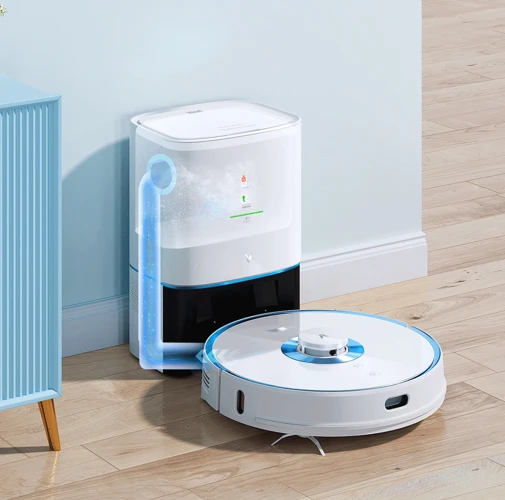
UV sterilization technology in smart vacuum cleaners presents a plethora of benefits for homeowners. Here are the top advantages of using a smart vacuum cleaner equipped with UV sterilization technology:
Eliminates Bacteria and Viruses: UV sterilization technology in smart vacuum cleaners uses short-wavelength UV-C light to eliminate bacteria, viruses, and other harmful pathogens. This technology is highly effective in killing germs and bacteria that are commonly found in carpets, rugs, and other surfaces. As a result, your home will be cleaner and healthier, providing a safer environment for you and your family.
Deodorizes Your Home: Smart vacuum cleaners with UV sterilization technology are also capable of deodorizing your home. The UV-C light breaks down the molecules that cause unpleasant smells, leaving your home smelling fresh and clean.
Prevents the Spread of Allergens: Smart vacuum cleaners with UV sterilization technology are also effective in preventing the spread of allergens. Allergens like dust mites, pet dander, and other irritants can trigger allergies and respiratory problems. By eliminating these allergens, UV sterilization technology can help ensure that your home is a healthy and allergen-free environment.
Less Exposure to Harsh Chemicals: UV sterilization technology in smart vacuum cleaners reduces the need for harsh chemicals that are often used in traditional cleaning methods. This means that you and your family will be less exposed to these chemicals, which can be harmful to your health.
UV sterilization technology in smart vacuum cleaners provides an effective and efficient way to keep your home clean and healthy. With the ability to eliminate bacteria, viruses, and allergens, as well as deodorizing your home and reducing your exposure to harsh chemicals, using a smart vacuum cleaner with UV sterilization technology is a smart choice for any homeowner.
Eliminates Bacteria and Viruses
UV Sterilization Technology works by emitting ultraviolet light that can penetrate the cell walls of bacteria and viruses, ultimately damaging their DNA or RNA and rendering them unable to reproduce.
This technology is particularly effective at eliminating bacteria and viruses that may linger on surfaces in the home, such as the kitchen counter, bathroom sink, or door handles. When incorporated into a smart vacuum cleaner, UV sterilization technology can help to eliminate up to 99.9% of bacteria and viruses in our homes.
The benefits of this technology are numerous. By eliminating harmful microorganisms, we can prevent the spread of illness and disease, making our homes healthier and safer environments for ourselves and our families. This is particularly important for households with young children or elderly individuals who may be more susceptible to illness.
UV sterilization technology is not only effective at eliminating harmful microorganisms, but it is also a natural and chemical-free way of doing so. This means that we can avoid the use of harsh chemicals and cleaners that may not only damage surfaces in our homes but may also have negative impacts on our health and the environment.
However, it is important to remember that UV sterilization technology is not a replacement for regular deep cleaning. While it is effective at eliminating surface-level bacteria and viruses, it may not reach deeper levels of dirt and grime that may require more intensive cleaning methods.
The use of UV sterilization technology in smart vacuum cleaners is a promising development in home cleaning technology, offering a natural and effective way to keep our homes healthier and free from harmful microorganisms.
Deodorizes Your Home
UV sterilization technology in smart vacuum cleaners not only eliminates germs and allergens but also deodorizes your home. For many people, the presence of bad odors in the home can be a source of discomfort. Traditional cleaning methods such as using air fresheners and scented candles may just mask the odor temporarily, but UV sterilization goes beyond this by neutralizing the source of the odor.
So how does UV sterilization technology deodorize your home? When UV light penetrates the cell walls of bacteria and viruses, it breaks down their molecular structure. As a result, these microorganisms cannot reproduce or cause further harm. Bad odors in your home are usually caused by molecules that are too large for traditional air fresheners to mask or remove. UV sterilization technology breaks down these molecules at a molecular level. This means that even if you have been cooking strong-smelling food or have pets that have left a distinct smell, UV sterilization will make sure that the molecules that cause these odors are eliminated.
The UV light used in smart vacuum cleaners penetrates deep into your carpets, furniture, and other surfaces in your home. This means that the odor-causing bacteria and microbes that are hidden deep within these surfaces will be destroyed as well. Your home will smell fresher and cleaner, without the need for harmful chemicals or air fresheners.
What are the benefits of deodorization? A clean and fresh-smelling home can have a positive impact on your mood and wellbeing. It can help you relax and feel more comfortable in your own space. A home that smells clean and fresh can be a welcoming environment for guests.
Despite the benefits of deodorizing your home with UV sterilization, there are some drawbacks to keep in mind. One of the main drawbacks is that it may require more time and energy to fully deodorize your home, especially if there are deep-seated odors that have built up over time. Additionally, it’s important to remember that UV sterilization technology is not a replacement for deep cleaning. While it may help to eliminate odor-causing microbes, regular cleaning and maintenance are still necessary to keep your home in top shape.
UV sterilization technology in smart vacuum cleaners can help to eliminate bad odors in your home while also killing germs and viruses. This technology represents a safer and more effective way to achieve a clean and healthy home environment without relying on harsh chemicals or masking agents. By incorporating UV sterilization technology into your cleaning routine, you can enjoy the benefits of a fresh-smelling and germ-free home.
Prevents the Spread of Allergens
One of the many benefits of UV sterilization technology in smart vacuum cleaners is its ability to prevent the spread of allergens in your home. Allergens, such as dust mites, pet dander, and pollen, can cause a range of uncomfortable symptoms, from sneezing and coughing to itchy eyes and skin.
Fortunately, UV sterilization technology can help reduce the number of allergens in your home. When the UV light bulbs in a smart vacuum cleaner shine on surfaces, they damage the DNA of bacteria and viruses, effectively killing them. This process also works on microscopic allergens, making it an effective way to reduce their presence.
In addition to eliminating allergens, UV sterilization technology also helps prevent their spread. When allergens accumulate on surfaces, they can easily become airborne and spread throughout your home when disturbed. This is especially true during cleaning, when vacuuming or dusting can kick up allergen particles into the air.
However, by using a smart vacuum cleaner with UV sterilization technology, you can destroy allergens on surfaces before they become airborne. This can help prevent the spread of allergens, making it easier for allergy sufferers to breathe easier and enjoy their homes.
It’s important to note that UV sterilization technology is not a complete solution for allergies. While it can certainly help reduce the number of allergens in your home, it should not replace other allergy management strategies, such as regular dusting, washing bedding in hot water, and using air purifiers.
UV sterilization technology is an effective addition to smart vacuum cleaners for those looking to reduce the presence and spread of allergens in their homes.
Less Exposure to Harsh Chemicals
Smart vacuum cleaners with UV sterilization technology offer a great benefit of reducing the use of harsh chemicals in your home. Traditional cleaning products such as bleach, ammonia, and other disinfectants contain toxic chemicals that can be harmful to your health and the environment. However, the UV sterilization technology in smart vacuums provides a chemical-free alternative for cleaning and disinfecting.
UV light is effective at killing germs and bacteria by damaging their DNA and preventing their reproduction. As a result, smart vacuums with UV sterilization can effectively eliminate dangerous bacteria such as E. coli and staphylococcus, which are commonly found on floors and surfaces. It cannot only disinfect but also deodorize your home by breaking down the molecules responsible for unpleasant odors.
By using a smart vacuum cleaner with UV sterilization technology, you can reduce your exposure to harsh chemicals while maintaining a clean and healthy living environment. This is especially important for those who suffer from asthma, allergies, or chemical sensitivities, since these individuals are more affected by the use of traditional cleaning products.
However, it is important to note that while UV sterilization technology in smart vacuums can reduce the use of harsh chemicals, it is not a complete replacement for deep cleaning methods. Even though a UV sterilization cycle in a smart vacuum can eliminate bacteria and viruses on surfaces, it cannot effectively remove dirt, debris, or stains. Smart vacuum cleaners with UV sterilization technology are best used as a supplementary cleaning tool in your home, along with traditional cleaning methods as needed.
The UV sterilization technology in smart vacuum cleaners is a great alternative to harsh chemicals for cleaning and disinfecting your home. It provides a chemical-free option to kill germs and bacteria, deodorize your home, and reduce your exposure to harmful toxins. However, it is important to use it in conjunction with other cleaning methods as needed for a complete clean.
Drawbacks of UV Sterilization in Smart Vacuum Cleaners
While UV sterilization technology has numerous benefits for cleaning your home, there are still some drawbacks that should be taken into consideration before investing in a smart vacuum cleaner with UV sterilization capabilities.
Not a Replacement for Deep Cleaning
Firstly, it is important to note that UV sterilization should not be viewed as a replacement for deep cleaning. While it may eliminate bacteria and viruses on surfaces, it does not physically remove any dirt or debris that may be present. This means that while your home may be sanitized, it may not necessarily be visibly clean.
Requires More Time and Energy
Additionally, the UV sterilization cycle in smart vacuum cleaners can take a significant amount of time and energy to complete. This can be a disadvantage for those who require quick and efficient cleaning, or for those who are looking to conserve energy. The UV light bulbs in smart vacuum cleaners may require regular replacement, which can add an additional cost to the machine’s maintenance.
It’s important to be aware of these drawbacks, but they shouldn’t deter you from considering a smart vacuum cleaner with UV sterilization technology altogether. While it may not be a complete solution for deep cleaning, it’s still a valuable tool for keeping your home sanitary and reducing the spread of allergens and odors.
Not a Replacement for Deep Cleaning
Although UV sterilization technology is an efficient way to eliminate bacteria, germs, and allergens in your home, it should not replace deep cleaning. UV sterilization technology can be instrumental in reducing the number of bacteria and viruses in your home, but it cannot clean up surface grime or remove deep-seated dirt and dust.
UV sterilization technology works by emitting ultraviolet light, which targets bacteria and viruses on surfaces. However, this technology is not effective against debris and dirt that are not exposed to the UV light. It is essential to carry out deep cleaning periodically to keep your home pristine and reduce the risk of illness.
Deep cleaning involves scrubbing surfaces with water, a cleaning solution, and a brush to remove dirt, grime, and debris. This process is more effective in removing all types of contaminants, not just bacteria and viruses. You should deep clean your home at least once every six months, depending on how often you use the space.
If you rely solely on UV sterilization technology to clean your home, you may still be exposed to dirt, dust, and other pollutants. Although UV sterilization technology can reduce the number of bacteria and viruses in your home, it cannot remove all contaminants in the air or on surfaces. It is essential to incorporate deep cleaning into your home cleaning regimen to ensure optimal results. By doing so, you will eliminate bacteria and viruses while also ensuring that your home is clean and free of any other contaminants.
Requires More Time and Energy
Although UV sterilization technology in smart vacuum cleaners is undoubtedly effective, it should be noted that it does come with some drawbacks. One of the main drawbacks is that the process requires more time and energy.
Time – UV sterilization technology typically requires the vacuum cleaner to spend more time in a specific area in order to effectively neutralize any potential bacteria or viruses. This means that the vacuuming process may take longer than usual if you are relying solely on UV sterilization technology.
Energy – In order to effectively sterilize an area with UV light, the vacuum cleaner may need to use more energy than a regular vacuum cleaning cycle. This could be a concern for those who are conscious of their energy usage and prefer to use products that are more energy-efficient.
It’s important to weigh the benefits and drawbacks of UV sterilization technology in smart vacuum cleaners before deciding whether or not it’s the right choice for your cleaning needs. While it can be highly effective at eliminating harmful bacteria, viruses, and allergens, it may require more time and energy than traditional vacuum cleaning methods.
Conclusion
In conclusion, UV sterilization technology in smart vacuum cleaners is a great innovation in home cleaning. The technology works by using UV light bulbs that eliminate bacteria, viruses, and other harmful pathogens in your home. By deodorizing your home, preventing the spread of allergens, and reducing exposure to harsh chemicals, UV sterilization technology offers many benefits.
While there are a few drawbacks, such as not being a replacement for deep cleaning and requiring more time and energy, the pros outweigh the cons.
However, it’s important to keep in mind that UV sterilization technology should not be the only method of cleaning your home. It should be used in conjunction with other cleaning methods for maximum effectiveness.
Overall, UV sterilization technology is an excellent addition to the smart vacuum cleaner industry. With its ability to keep your home free of harmful pathogens, it’s definitely worth considering for those who prioritize a clean and healthy living environment.
Frequently Asked Questions
What is the difference between UV sterilization and regular vacuuming?
UV sterilization technology kills bacteria and viruses by using ultraviolet light, while regular vacuuming only removes dirt and dust from surfaces.
Is UV sterilization safe for human exposure?
Yes, UV sterilization technology is safe for human exposure when used properly. However, it is important to avoid direct exposure to the UV light.
Can UV sterilization technology be used on all surfaces?
No, UV sterilization technology is most effective on hard surfaces such as floors, countertops, and walls. It is not recommended for use on soft surfaces such as fabrics or carpets.
What is the lifespan of a UV light bulb in a smart vacuum cleaner?
The lifespan of a UV light bulb in a smart vacuum cleaner typically ranges from 6 months to 1 year, depending on usage and manufacturer recommendations.
How does UV sterilization technology compare to chemical cleaning products?
UV sterilization technology is a more eco-friendly and chemical-free option for cleaning and sanitizing surfaces. It is also effective at targeting hard-to-reach areas where chemical products may not be able to penetrate.
Can UV sterilization technology prevent the spread of COVID-19?
While UV sterilization technology can kill certain types of viruses, including coronaviruses, it is not a guaranteed measure to prevent the spread of COVID-19. It is important to continue following recommended hygiene practices such as hand washing and social distancing.
Are there any precautions I need to take when using a smart vacuum cleaner with UV sterilization technology?
It is important to avoid direct exposure to the UV light when using a smart vacuum cleaner with UV sterilization technology. It is also recommended to wear protective eyewear and clothing to avoid any potential skin irritation.
Can I use UV sterilization technology with my existing vacuum cleaner?
There are UV sterilization attachments available for purchase that can be used with existing vacuum cleaners. However, it is important to ensure compatibility and follow manufacturer recommendations.
How long does it take for UV sterilization technology to eliminate bacteria and viruses?
The length of time it takes for UV sterilization technology to eliminate bacteria and viruses varies depending on factors such as the size of the area being cleaned, the strength of the UV light, and the duration of the cleaning cycle.
Is UV sterilization technology effective against mold and mildew?
UV sterilization technology can help prevent the growth of mold and mildew on surfaces by eliminating the bacteria that contribute to their growth. However, it is not a replacement for correcting underlying moisture issues that may lead to mold and mildew growth.

